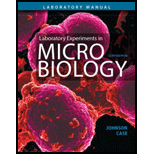
Concept explainers
To analyze:
If there was no growth on the DNA + E. coli plates, then what will happen.
Introduction:
Transformation is the process in which horizontal gene transfer takes place. For transformation to occur, a cell must be competent to take up the foreign gene. Either the cell is naturally competent, or these are chemically or electrically treated to make them competent.
Explanation of Solution
Natural transformation helps bacteria to gain an extra-chromosomal copy of DNA, called a plasmid which provides many antibiotic resistance genes to the host cell. The artificial transformation has various applications in molecular biology and
Before the transformation, the cells are first made competent. For example, in the transformation of the DH5 alpha strain of e. coli, the cells are first made competent by treating them with calcium chloride and giving heat shock. These cells are then plated on ampicillin LB agar plates to observe whether they have received a foreign DNA insert or not.
If there is no growth on the DNA + Escherichia coli plates, then it indicates transformation has not taken place. This can occur due to the following reasons:
1. Cells have not become competent (competence is the ability of cells to uptake foreign DNA). heat-shock step must be repeated, or different strains of cells must be.
2. DNA of interest might be extracted directly from the plant or mammalian cells and contain methylated cytosine. Methylated cytosine is degraded by many E. coli cells.
3. Too much ligation mixture might have been used. Only 5 micro lire (μl) or less, ligation mixture should be used during transformation.
4. Inefficient ligation might have occurred. To avoid this, vector to insert molar ratio must be changed from 1:1 to 1:10, DNA must be purified to remove contaminants such as salts and EDTA, removal of phosphate before ligation should be done.
Thus, ifthere is no growth on the DNA + Escherichia coli plates, then it indicates transformation has not taken place.
Want to see more full solutions like this?
Chapter 31 Solutions
Laboratory Experiments in Microbiology (12th Edition) (What's New in Microbiology)
- Why was there a greater A260 absorbance reading for your DNA sample that was incubated at higher temperatures?arrow_forwardUsing what you now know about restriction enzymes, why do you suppose that wells in the gel contained more than one band?arrow_forwardIf the purity of DNA sample is below 1.8 A260/A280, where did the protein contamination come from?arrow_forward
- why was glycerol added onto the total dna buffers?arrow_forwardIn figure 10.16 , how would the curve appear if the GC content of the DNA sample were increased? How would the curve appear if the AT content were increased?arrow_forwardWhich type of electrophoresis does this image depict ?arrow_forward
 Human Anatomy & Physiology (11th Edition)BiologyISBN:9780134580999Author:Elaine N. Marieb, Katja N. HoehnPublisher:PEARSON
Human Anatomy & Physiology (11th Edition)BiologyISBN:9780134580999Author:Elaine N. Marieb, Katja N. HoehnPublisher:PEARSON Biology 2eBiologyISBN:9781947172517Author:Matthew Douglas, Jung Choi, Mary Ann ClarkPublisher:OpenStax
Biology 2eBiologyISBN:9781947172517Author:Matthew Douglas, Jung Choi, Mary Ann ClarkPublisher:OpenStax Anatomy & PhysiologyBiologyISBN:9781259398629Author:McKinley, Michael P., O'loughlin, Valerie Dean, Bidle, Theresa StouterPublisher:Mcgraw Hill Education,
Anatomy & PhysiologyBiologyISBN:9781259398629Author:McKinley, Michael P., O'loughlin, Valerie Dean, Bidle, Theresa StouterPublisher:Mcgraw Hill Education, Molecular Biology of the Cell (Sixth Edition)BiologyISBN:9780815344322Author:Bruce Alberts, Alexander D. Johnson, Julian Lewis, David Morgan, Martin Raff, Keith Roberts, Peter WalterPublisher:W. W. Norton & Company
Molecular Biology of the Cell (Sixth Edition)BiologyISBN:9780815344322Author:Bruce Alberts, Alexander D. Johnson, Julian Lewis, David Morgan, Martin Raff, Keith Roberts, Peter WalterPublisher:W. W. Norton & Company Laboratory Manual For Human Anatomy & PhysiologyBiologyISBN:9781260159363Author:Martin, Terry R., Prentice-craver, CynthiaPublisher:McGraw-Hill Publishing Co.
Laboratory Manual For Human Anatomy & PhysiologyBiologyISBN:9781260159363Author:Martin, Terry R., Prentice-craver, CynthiaPublisher:McGraw-Hill Publishing Co. Inquiry Into Life (16th Edition)BiologyISBN:9781260231700Author:Sylvia S. Mader, Michael WindelspechtPublisher:McGraw Hill Education
Inquiry Into Life (16th Edition)BiologyISBN:9781260231700Author:Sylvia S. Mader, Michael WindelspechtPublisher:McGraw Hill Education





